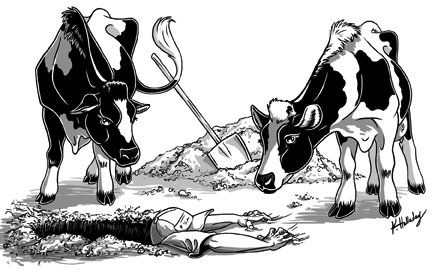How deep a financial hole did milk producers dig in 2009? It was "Lassie, go get help!" deep.
 It was a horribly serious situation whose magnitude was simply absurd. High feed costs and a collapse in milk prices created the worst financial squeeze for dairies since the Great Depression. Now the question is, will its effects linger for years or decades?
It was a horribly serious situation whose magnitude was simply absurd. High feed costs and a collapse in milk prices created the worst financial squeeze for dairies since the Great Depression. Now the question is, will its effects linger for years or decades?
According to average income and cost of production data provided by Genske, Mulder & Co., CPAs, the nation's largest dairy accounting firm, the average loss for all of its clients was a staggering $655 per cow.
Not surprisingly, the main cause was feed. According to the firm, average feed cost for the entire year was $8.27 per hundredweight. By comparison, feed cost in 2006 was $6.21 – and that was an across-the-board loss year, too.
No dairy went through the equity bonfire (declining land, cattle, and facility values) that raged out of control most of the year without getting scorched. Some net worth sheets went up in smoke completely. Most were so badly singed it will take years to recover. Others may take decades.
Even if milk prices eventually return to $20+ levels, Bruce Miles, a partner at Genske, Mulder & Co. says it will take more than one good year to repair the damage. In the meantime, dairies have little if any financial "safety net" to protect them from another downturn, even a mild one.
"Dairies have a lot of debt to repay," he emphasizes. "If we do see $20 milk again, most people won't get back to where they were even if it lasts for two years. It would probably take more like three or four years, and we've never seen prices that high for anywhere near that long before."
 It was a horribly serious situation whose magnitude was simply absurd. High feed costs and a collapse in milk prices created the worst financial squeeze for dairies since the Great Depression. Now the question is, will its effects linger for years or decades?
It was a horribly serious situation whose magnitude was simply absurd. High feed costs and a collapse in milk prices created the worst financial squeeze for dairies since the Great Depression. Now the question is, will its effects linger for years or decades?According to average income and cost of production data provided by Genske, Mulder & Co., CPAs, the nation's largest dairy accounting firm, the average loss for all of its clients was a staggering $655 per cow.
Not surprisingly, the main cause was feed. According to the firm, average feed cost for the entire year was $8.27 per hundredweight. By comparison, feed cost in 2006 was $6.21 – and that was an across-the-board loss year, too.
No dairy went through the equity bonfire (declining land, cattle, and facility values) that raged out of control most of the year without getting scorched. Some net worth sheets went up in smoke completely. Most were so badly singed it will take years to recover. Others may take decades.
Even if milk prices eventually return to $20+ levels, Bruce Miles, a partner at Genske, Mulder & Co. says it will take more than one good year to repair the damage. In the meantime, dairies have little if any financial "safety net" to protect them from another downturn, even a mild one.
"Dairies have a lot of debt to repay," he emphasizes. "If we do see $20 milk again, most people won't get back to where they were even if it lasts for two years. It would probably take more like three or four years, and we've never seen prices that high for anywhere near that long before."








